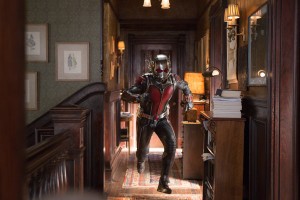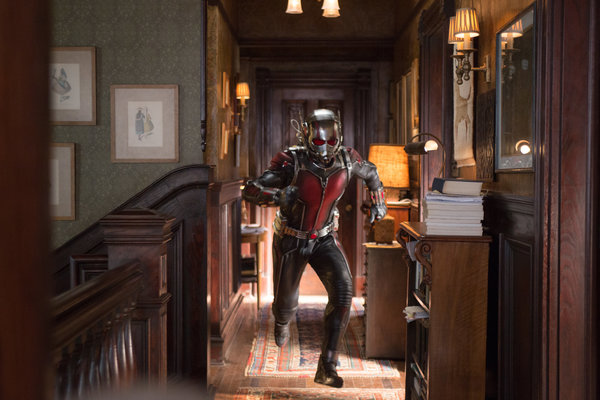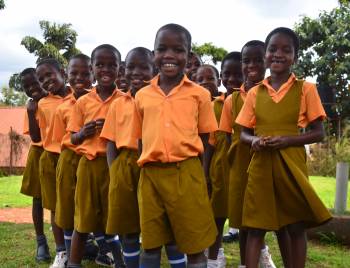Interview: Shepherd Frankel, Production Designer for “Ant-Man”
Posted on November 30, 2015 at 3:59 pm
Shepherd Frankel is the production designer who created the world of “Ant-Man,” the Marvel film about the teeny little superhero named Scott Lang and played by Paul Rudd. It will be released on DVD/Blu-Ray December 8, 2015. I loved the design of the film, and it was an honor to get to ask him about it.

Ant-Man/Scott Lang (Paul Rudd)
Photo Credit: Zade Rosenthal
© Marvel 2015
So when you come into a movie like this are you more excited or terrified at the idea that you’re going to have to create a world where somebody is the size of an ant?
I used to say, “If you’re not scared going go to work every day you are going to need to find a new job,” meaning there is an exhilaration to being nervous at the task of doing an amazing job. I definitely felt that on a day-to-day basis on “Ant-Man” but it wasn’t fear. It was more like wanting to make sure that we could take advantage of every opportunity in the script and in the Marvel cinematic universe, to bring this film into its most receivable and exceptional form. And I do feel like we did, it’s almost like I never wanted to let any rock be uncovered. I would say that this film was definitely the most fun I have had making a movie.
And I think you can see that on the screen. It was a testament to the filmmakers, the Director, Marvel, our producers and the environment that they created. When I saw it for the first time I was tickled at the visual journey that we were on which was a byproduct of many different departments and everyone’s effort. I thought it was an exceptionally fun visual journey we just went on and I felt like literally creatively — like wow! I’m happy, I just felt like I ate a great meal. So I was nervous but only nervous about wanting to make sure we fulfilled all of the opportunities and possibilities that were implied and that we came up with as a result of investing in the story and the characters.
There were two very different and very character-defining settings in the film, the house that Hank Pym, the Michael Douglas character, lived in and the lab owned by the movie’s villain, Darren Cross, played by Corey Stoll.
Hank Pym is a retired scientist and he needed to be in an older house. We wanted the house to be quintessential San Francisco. So we found a location and we ended up painting the entire thing and building a huge gate around outside so Scott could jump over it. This house was in San Francisco and the color was tied into the color palette of Michael Douglas. It felt like it was from another time. The entire inside of that house, the main story, the top story and the basement were all built on stage in Atlanta. And also the back of the house where Scott jumps off and breaks in at the window where he came up in the yard through the ground, we built that outside in Atlanta.
So basically the idea was you want it to feel like, “Oh there is some old guy living in this house.” When you meet him Scott doesn’t know he is Hank Pym, the genius. We think of him as this old guy whose house shows that his work had kind of taken over his house and it was loved and nurtured at one point but it has seen better days and it has a little clutter and so you see it and think, “What’s going on here? What’s the backstory?” And then when you go downstairs in the basement it’s like “What the heck is this?” There is a vault and a high-tech wall and a gym that was the best of its time in the 70s and that’s where Ant-Man trained.
So the challenge there was that the space had two meanings, one as we first see it but two the surprise that “Wow, this is the place that Hank Pym developed the technology for the Ant-Man suit in this secure vaulted world.” Then you counter that with the laboratory which was this mid-century old building which is where Hank Pym went after he retired the Ant-Man suit.
But then there is the lab, in contrast. The story that Darren Cross had taken over that lab and pushed Hank Pym out of his own company and created this tactical laboratory that was always like a machine, the casino that you kind of felt like you were being devoured by you are being devoured by the technology of the architecture of this building. The way Darren Cross kind of like chew you up and spit you out and like it needed be so obviously Hank Pym warmer colors, brown, wood, a Victorian home and then Darren Cross, metal and blue and glass and icy and steel and cold. So you needed two characters in one. And one of the fun things is that Hank Pym’s labs in 1970, what did that place look like and it is basement that thing was so much fun to do that in juxtaposition to Cross technology, like the future walls and the future lab.
What was the biggest challenge you had in indicating the scale as Ant-Man shrinks down?
We had to think about everything two times. First was the usual “Okay, we’re doing all these sets and the movie takes place in this like a regular world of like a Victorian home or a jail, or tenement housing and then we go to these labs,” and you’re like, “Okay that’s cool.” But then we see those spaces again when he shrinks down. So we did a lot of math in the beginning, meaning like if Scott shrinks down to this size what does the environment look like to him? And the way I lay out a set is all based on the scale and relationship of character to environment and the way the camera is going to perceive that. So when you shrink someone down and suddenly a one or two foot tile for an ant-size person is basically 400 feet. So that tile has to create interesting cinematic obstacles and depth. We were constantly thinking about how it exists for someone an inch tall in an environment that we already designed full-scale?
So I was always building set within set, the real set and then the macro set and we always shot the macro environment on the actual environment. I never built like an oversized spoon or fork or cup, everything was shot within camera of the original size set. Sometimes we would rebuild it if the schedule required us to have the macro set ready when the first unit was on the original set but ultimately we built these environments for us to capture the digital assets for visual effects, who would then have Scott and Ant Man running through these environment at that scale. It was a combination scientific and creative kind of solutions which was only achievable by virtue of new technology and Frazier lenses and various ways to capture things with cameras these days. We could not have done these like 10 or 15 years ago.



